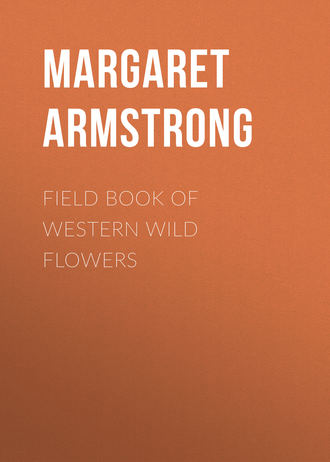 полная версия
полная версияField Book of Western Wild Flowers
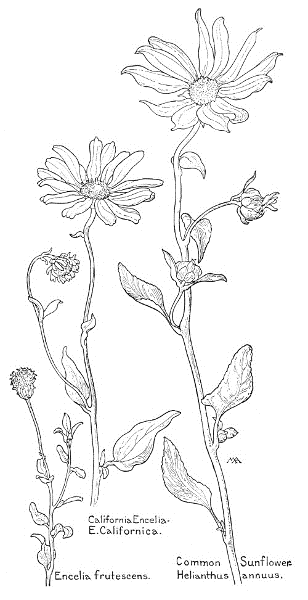
California Encelia – E. Californica.
Encelia frutescens.
Common Sunflower – Helianthus annuus.
Sunflower
Heliánthus fasciculàris
Yellow
Spring
Nev., Ariz., etc.
A handsome kind, forming a clump from two to four feet high, with several leafy, rough stems and harsh, rather shiny leaves. The fine flowers measure four inches across, with bright yellow rays, deeper yellow centers, and bronze, rough, rather resinous involucres. This is common around Reno and grows in dry mountain valleys as far east as Colorado.
Hairy Golden Aster
Chrysópsis villòsa
Yellow
Summer
Arizona, etc.
A striking plant, quite handsome, with a hairy, pale, leafy stem, from six inches to two feet tall, and gray-green, rather velvety leaves, generally toothless. The flowers are an inch or more across, with bright golden-yellow rays and centers of the same shade, growing singly, or in a more or less crowded cluster at the top of the stalk. This is common in open ground and dry hills, up to an altitude of ten thousand feet, as far east as Alabama, and there are many varieties. The Greek name means "golden aspect."
Velvet-rosette
Psathyròtes ánnua
Yellow
Spring
Southwest
A curious and pretty little desert plant, that looks as if it were trying to protect itself from cold rather than heat, as its pretty foliage and stems seem all made of silvery, gray velvet, forming a symmetrical rosette, dotted with the small, rayless, yellow flower-heads, like fuzzy buttons. The rosette is decorative in form, about a foot across, spreading flat and close to the ground, and is conspicuous on the bare sand of the desert. Only one of the branches is given in the picture.
Easter Daisy, Ground Daisy
Townséndia exscàpa
Pink
Spring
Ariz., New Mex. to Saskatchewan
This is a charming and quaint little plant, with close, downy rosettes of small, gray-green leaves and two or three, pretty, daisy-like flowers, all crowded together close to the ground. The flowers are over an inch across, with numerous, pale-pink rays, deeper pink on the under side, and a bright yellow center, and when they bloom in early spring, on bare rocky soil, they are exceedingly attractive.
There are a great many kinds of Erigeron, widely distributed, most abundant in the New World, easily confused with Asters, but usually with numerous and finer rays, so that the effect is more delicate.
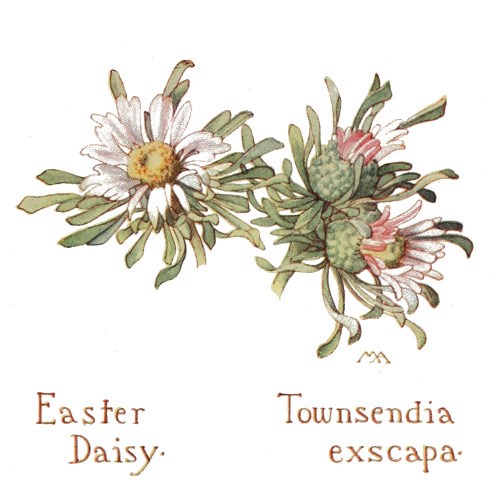
Easter Daisy – Townsendia exscapa.
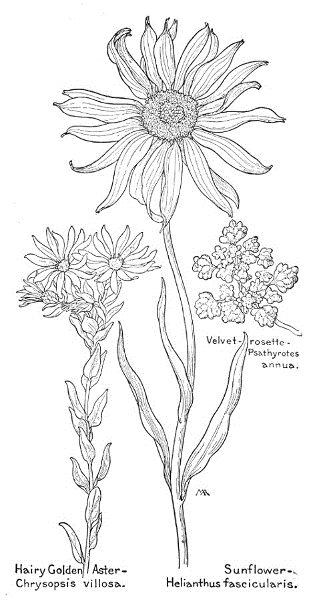
Velvet-rosette – Psathyrotes annua.
Hairy Golden Aster – Chrysopsis villosa.
Sunflower – Helianthus fascicularis.
Fleabane
Erígeron Bréweri
Purple
Summer
California
This is rather pretty, with slender, brittle, downy stems, from six to eighteen inches tall, and small, narrow, rough, dull green leaves. The flowers grow singly, at the ends of short leafy branches, and are each less than an inch across, with rather few violet or pinkish-purple rays and a yellow center. This is common around Yosemite and looks a good deal like an Aster.
Whip-lash Fleabane
Erígeron flagellàris
White, pink
Summer
Ariz., Utah, etc.
A rather odd-looking plant, with numerous, very slender, weak, branching stems, trailing on the ground, and very small, toothless, grayish-green, downy leaves, forming a rather dense, low bush, about two and a half feet across, the long sprays interlacing and dotted here and there with pretty little flowers, with numerous fine, white, pink-tipped rays and a yellow center. The sprays often take root at the tip. This grows in the Grand Canyon, and is found as far east as Colorado.
Rayless Fleabane
Erígeron concínnus var. aphanáctis
Yellow
Spring
Utah, Nev., Cal. etc.
A rather attractive little plant, forming small clumps, about five inches high, with several very hairy stems and light dull green, very hairy leaves. The many flower-heads are less than half an inch across, deep yellow, without rays. This grows on dry plains and mesas, as far east as Colorado, and has a rather starved appearance.
Spreading Fleabane
Erígeron divérgens
Violet
Spring, summer, autumn
West, etc.
A dear little common plant, from six to fifteen inches high, with several slender, branching, hairy stems, and soft, hairy, gray-green leaves, the upper ones small and narrow, without leaf-stalks and the lower ones sometimes with two or three lobes and with leaf-stalks. The flower-heads, several or many, on slender flower-stalks, measure nearly an inch across in spring, but are smaller in summer, and have numerous very narrow rays, white towards the center, shading to bright violet or pink at the tips, with a bright yellow center. This often grows in quantities on dry plains and mountain-sides, as far east as Texas, and is quite charming, the tufts of foliage, dotted with pretty delicate little flowers, not touching each other, but sprinkled over a large space, recalling the little flowers in early Italian pictures. E. pùmilis, of the Northwest and Utah, is much the same, with white rays.
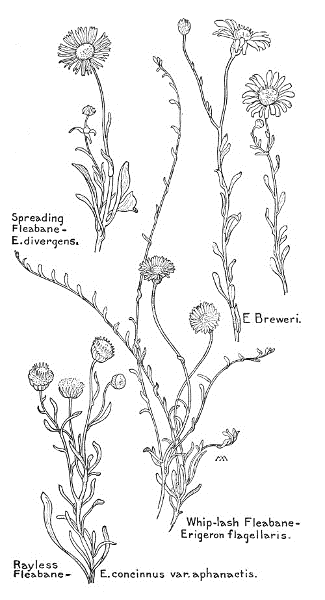
Spreading Fleabane – E. divergens.
E Breweri.
Whip-lash Fleabane – Erigeron flagellaris.
Rayless Fleabane – E. concinnus var. aphanactis.
Large Mountain Fleabane
Erígeron salsuginòsus
Lilac
Summer
West, etc.
A large, handsome kind, abundant in the higher mountains and growing in moist places, as far east as Colorado. The stems are downy and leafy, from one to two feet tall, the leaves are smooth or slightly hairy, with bristle-like points, and the flowers are an inch and a half or more across, with bright yellow centers and clear bright lilac rays, not very narrow.
Yellow Fleabane
Erígeron àureus (Aplopappus Brandegei)
Yellow
Summer
Wash., Oreg.
A little alpine plant, about three inches tall, with downy stems, thickish, gray-green leaves, covered with close white down and forming a mat of foliage on the rocks at high altitudes. The flowers are rather more than half an inch across, with a woolly involucre, dark yellow center, and deep yellow rays, an unusual color among Fleabanes.
Seaside Daisy, Beach Aster
Erígeron glàucus
Violet, pink
Spring, summer
Cal., Oreg.
Very cheerful, sturdy-looking flowers, with stout, hairy stems, four to ten inches tall, and stiffish, slightly hairy leaves, rather pale in color. The handsome flowers are an inch and a half across, with numerous violet, lilac, or pink rays and rather dark yellow centers. This grows near the sea and is common on cliffs and sandy shores, where it makes beautiful spots of bright color.
Skevish, Philadelphia Fleabane
Erígeron Philadélphicus
Pink, mauve
Spring, summerU. S.
A pretty perennial, from one to three feet tall, usually soft and hairy, the slender stems usually branching above and most of the leaves toothed. The flowers usually form a loose cluster at the top, the buds drooping, and the heads are from half an inch to an inch across, with yellow centers and a very feathery fringe of pink or pinkish rays. This grows in fields and woods. There is a picture in Mathews' Field Book. E. Còulteri, the large White Mountain Daisy, is a beautiful kind, from six to twenty inches tall, with bright green leaves, often toothed, sometimes downy, and the flowers usually single, an inch and a half across, usually with pure white rays. This grows in Yosemite meadows and similar mountain places, in Utah, California, and Colorado. E. compósitus is a little Alpine plant, forming dense leafy mats, easily recognized by the broad tips of the leaves being cut into lobes, usually three. The flowers are an inch or more across, with violet or white rays. This grows on the granite peaks around Yosemite, and in other Alpine regions, as far east as Colorado.
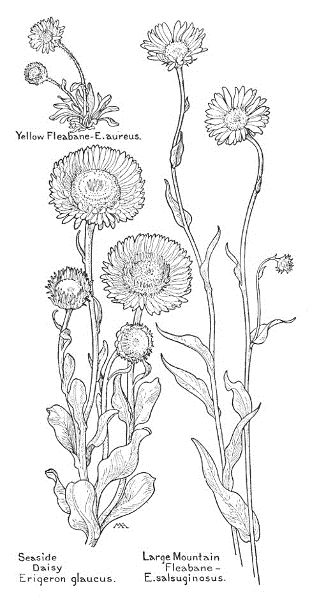
Yellow Fleabane – E. aureus.
Seaside Daisy – Erigeron glaucus.
Large Mountain Fleabane – E. salsuginosus.
Ptilonella
Ptilonélla scàbra (Blepharipappus)
White
Spring
Oreg., Ida., Nev., Cal.
A charming little desert plant, graceful and airy in character, with stiff, very slender, branching, roughish stems, about ten inches tall, and dull green leaves, very rough to the touch, with the edges rolled back. The delicate little flowers are an inch across, with pure white rays, and with white centers, which are specked with black and pink. This is common on the mesas around Reno and looks much like some kinds of Madia.
Desert Holly
Perèzia nàna
Pink
Spring
Ariz., Tex.
An odd little desert plant, only two or three inches high, with stiff, smooth, dull bluish-green leaves, with prickly edges, like holly leaves but not so stiff, and one quite pretty, light purplish-pink flower, the head about an inch long, with purplish bracts. The effect of the whole plant is of a little sprig stuck into the sand.
Brown-foot
Perèzia Wrìghtii
Pink
Spring
Ariz., Tex.
Much like the last, but more commonplace looking, for the flowers are smaller and the plant much larger. It is about a foot high and grows among rocks, and the general effect of dull mauve is rather pretty, though not bright in color. The common name alludes to the plant being covered with a mass of brown hairs at the base.
There are several kinds of Gutierrezia, all American.
Brown-weed
Gutierrèzia Saròthrae (G. Euthamiae)
Yellow
Summer, autumn
West, etc.
A bushy plant, resinous, smooth or nearly so, from six inches to two feet high, with many stiff, upright branches and alternate, toothless, narrow leaves, an inch or so long. The flowers have yellow centers and small yellow rays, forming clusters at the ends of the branches, and though very small are so numerous as to make effective clumps of bright color. This grows at the Grand Canyon, and in dry rocky places, as far east as the Central States.

Ptilonella – P. scabra.
Brown-foot – Perezia Wrightii.
Desert Holly – P. nana.
There are a good many kinds of Helenium, natives of North and Central America.
Sneeze-weed
Helènium Bigelòwii
Yellow
Summer, autumn
Cal., Oreg.
A handsome plant, with a roughish stem, from two to four feet tall, and toothless, rather coarse leaves, rougher on the underside, the lower part of the leaf grown to the stem along its middle in a curious way. The flowers are from an inch and a half to two inches across, with bright golden-yellow rays and a rich-brown center, powdered with yellow pollen, and the budding flower heads look like brown buttons. This grows in meadows and along streams, at moderate altitudes, and is found in Yosemite.
Hymenopáppus lùteus
Yellow
SummerAriz., New Mex., Col., Utah
A pretty and rather unusual-looking plant, with a cluster of root-leaves, gray-green and downy, cut into many fine divisions, and slender stems, about a foot tall, with two or three, narrow, alternate, toothless leaves, and bearing at the top a few pretty, bright yellow flower-heads, nearly an inch across, with tube-shaped flowers only. This grows in dry, open places.
There are many kinds of Madia, sticky, heavy-scented herbs, commonly called Tarweed and called Madi in Chili. They are used medicinally by Spanish-Californians.
Common Madia, Tarweed
Màdia élegans
Yellow
Summer, autumn
West
Pretty flowers, with hairy stems, from six inches to three feet tall, and velvety or hairy leaves, more or less sticky and the upper ones alternate. The flowers grow in loose clusters and are from one to over two inches across, with bright yellow rays, sometimes with a spot of maroon at the base which gives an extremely pretty effect, and a yellow or maroon center. This often makes pretty patches of color in sandy places, and is widely distributed and very variable. Woodland Madia, M. madioìdes, is similar, but not so pretty.
Gum-weed
Màdia dissitiflòra
Yellow
Summer
California
A slender plant, over a foot tall, with hairy stem and leaves, which are aromatic when crushed, and rather pretty little flowers, about half an inch across, with pale yellow rays, yellow centers specked with black, and sticky-hairy involucres. This grows along roadsides and the edges of woods.
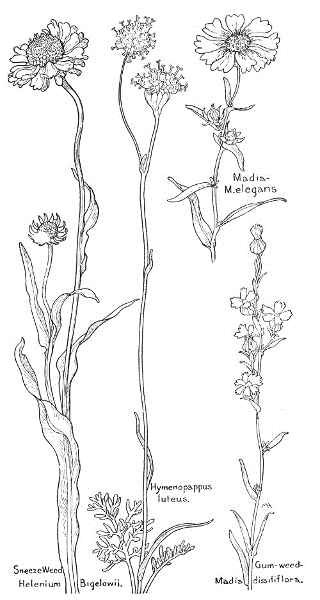
Madia – M. elegans.
Hymenopappus luteus.
Sneeze Weed – Helenium Bigelowii.
Gum-weed – Madia dissitiflora.
There are many kinds of Coreopsis, natives of America, South Africa, and Australasia, several of them cultivated in gardens. They are called Tickseed.
Desert Coreopsis
Coreópsis Bigelòwii
Yellow
Spring
California
This is very pretty, with one or several, slender, smooth stems, about ten inches tall, springing from a tuft of pretty, bright green, smooth, shiny leaves, cut into narrow divisions and slightly succulent. The flowers are an inch and a half to two inches across, with bright yellow rays, lighter at the tips, and an orange center, and look exceedingly pretty in the Mohave Desert.
Sea Dahlia
Coreópsis marítima (Leptosyne)
Yellow
Spring
California
A magnificent plant, forming large clumps, two feet high, but not at all coarse in character. The leaves are very bright green, smooth and quite succulent, and cut into narrow lobes, so that the effect is graceful and unusual looking. The superb flowers are often four inches across, with clear light yellow rays and orange-yellow centers, and the lower row of bracts stand out stiffly like a ruffle and are like the leaves in texture and color, contrasting oddly with the upper bracts, which are satiny in texture and almost as yellow as the rays. These plants are conspicuously beautiful on the sea cliffs near San Diego.
Trixis
Tríxis angustifòlia var. latiúscula
Yellow
Spring
Southwest, New Mex.
A small evergreen shrub, about a foot high, with smooth, light dull green leaves, with a few fine teeth, and loose clusters of rather pretty, bright yellow flowers, the heads about three-quarters of an inch long. This grows on rocky hillsides and is quite effective.
There are a great many kinds of Chrysanthemum, widely distributed in the northern hemisphere.
Ox-eye Daisy
Chrysánthemum Leucánthemum
White
Spring, summer, autumn
Northwest, etc.
This is the well known common kind, a general favorite, except with farmers, naturalized from Europe and also found in Asia; a perennial weed in pastures, meadows, and waste places, more or less all over the United States, but much more common in the Northeast. It grows from one to three feet high, the leaves toothed and cut, and the flower-heads measuring from one to two inches across, with bright golden centers and pure white rays.
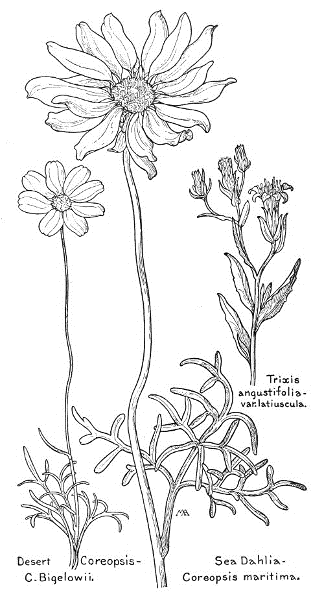
Trixis angustifolia – var. latiuscula.
Desert Coreopsis – C. Bigelowii.
Sea Dahlia – Coreopsis maritima.
There are several kinds of Coreothrogyne, some resembling Lessingia, others Aster.
Woolly Aster
Coreothrógyne filaginifòlia
Pink, purpleSpring, summer, autumn
California
This forms a clump from one to three feet high, with many erect stems, white with woolly down, at least when young, and crowded with alternate, pale grayish-green leaves, thin and soft in texture and covered with down. The flower-heads are an inch across, with purplish-pink rays and dark yellow centers, and contrast rather prettily with the pale foliage. In Yosemite this grows on rocky ledges below five thousand feet and blooms late. It is common from Monterey to Santa Barbara, blooming at almost all seasons, and is very variable.
Psilóstrophe tagetìna var. sparsiflòra (Riddellia)
Yellow
Spring, summer
Arizona
These flowers do not look much like those of a composite, but give more the effect of yellow Wallflowers. The plant is very attractive, from one to two feet tall, with alternate, bluish-green leaves, most of them toothless, and handsome clusters of lemon-yellow flowers. They are each about three-quarters of an inch across, delicately scented, and usually have four large rays, mixed with a few smaller and more irregularly shaped, all much more like petals than rays and becoming papery in fading. The picture is of a plant growing in the Grand Canyon.
Paper Flowers
Psilóstrophe Coòperi
Yellow
Spring
Southwest
A pretty, compact, shrubby plant, woody below, about a foot high, with tangled branches, pale downy twigs, and thickish, dull green, downy leaves. The pretty flowers are an inch and a quarter across, with an orange-yellow center and five or six, large, clear bright yellow rays, twisted to one side and puckered at the base, turning back and becoming papery as they fade. This plant is at its best in sandy soil and is very effective in the desert. When fully developed it is very symmetrical in outline, forming a charming yellow globe of flowers.
There are several kinds of Xylorrhiza, nearly related to the Aster group and by some authorities regarded as Asters.

Woolly Aster – Coreothrogyne filaginifolia.
Psilostrophe tagetina – var. sparsiflora.
Paper Flowers – P. Cooperi.
Xylorrhiza
Xylorrhìza tortifòlia
Lilac
Spring
Southwest, Utah, Col.
A handsome plant, growing in clumps over two feet high, with prickly leaves and beautiful flowers, two inches and a half across, with rays shading from bright lilac to nearly white and yellow centers. This is common in the Grand Canyon.
There are a good many kinds of Arnica, natives of the northern hemisphere. This is the ancient name and a European kind is much used medicinally.
Heart-leaved Arnica
Árnica cordifòlia
Yellow
Summer
West, except Ariz.
A handsome mountain flower, with a hairy stem, from six inches to two feet tall, and velvety leaves, coarsely toothed, the lower ones usually heart-shaped. The flower-heads are usually single, over two inches across, with bright yellow rays, an orange center, and a hairy involucre. This is common in rich moist soil in mountain valleys, as far east as Colorado.
Broad-leaved Arnica
Árnica latifòlia
Yellow
Summer
Northwest
A handsome kind, sometimes a foot and a half tall, with pretty flowers, about two inches across, with very bright yellow rays. The bright green leaves are thin in texture and practically smooth, the lower ones more or less roundish, with leaf stalks. This grows in mountain woods.
There are many kinds of Artemisia; herbs or shrubs, usually bitter and aromatic, widely distributed.
Common Sage-brush
Artemísia tridentàta
Yellow
Summer, autumn
West, etc.
This is the characteristic sort, often immensely abundant and found as far east as Colorado, often tinting the landscape for miles with its pale and beautiful foliage and one of the dominant shrubs in the Great Basin. It is very branching, from one to twelve feet high, with a distinct trunk and shreddy bark, and the twigs and alternate leaves are all gray-green, covered with silvery down, the upper leaves small and toothless, the lower wedge-shaped, with usually three, blunt teeth. The small yellow flowers have no rays and grow in small, close clusters, forming long sprays towards the ends of the branches. Sagebrush is a "soil indicator" and when the prospective rancher finds it on land he knows at once that it will be good for even dry farming, as the soil contains no salt or alkali.

Xylorrhiza tortifolia.
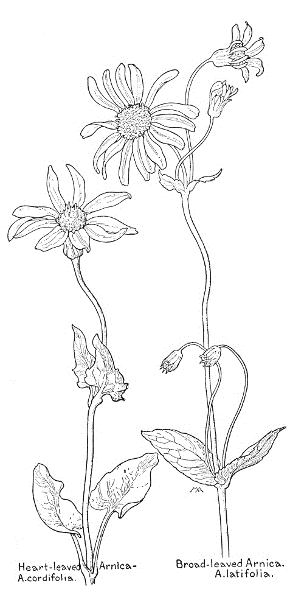
Heart-leaved Arnica – A. cordifolia.
Broad-leaved Arnica – A. latifolia.
There are a good many kinds of Eriophyllum, common and very variable, woolly plants.
Woolly Yellow Daisy
Eriophýllum lanàtum
Yellow
Spring, summer
Cal., Oreg., Wash.
This is a handsome kind, in favorable situations forming large conspicuous clumps, from one to two feet high, covered with bright golden flowers, each over an inch across. The leaves are dull green on the upper side, but the under side and the buds and stems are all covered with fine white down. The leaves are variable in form, sometimes neither lobed nor toothed, and sometimes cut into narrow toothed divisions. This has a variety of forms and grows on hillsides.
Eriophyllum
Eriophýllum caespitòsum var. integrifòlium
Yellow
Summer
Northwest, etc.
This forms low tufts of pale gray downy foliage, contrasting well with the bright yellow flower-heads, each about an inch across. This grows around Yosemite and in other mountain places, as far east as Wyoming, and has a variety of forms.
Golden Yarrow
Eriophýllum confertiflòrum
Yellow
Summer

